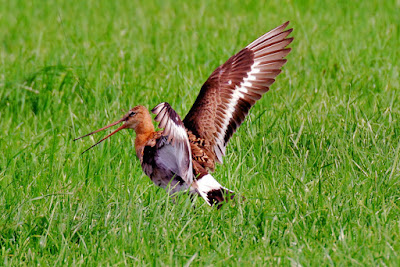I had just a couple of hours spare to whizz around the block this morning. It proved quite productive thanks to the usual spots of Conder Green and Cockersands with both Sedge Warblers and Whitethroats much in evidence. I also saw my first Whinchat of the spring.
There was a lot to see and hear at Conder Green, both in the creeks and on the pool. April and May is the peak time for the brick-red "Icelandic" Black-tailed Godwits that pass through this region, when many hundreds of them may appear at favoured locations. For example up to 1,000 this week at the RSPB reserve of Leighton Moss some 20 miles north of here.
I made do with just three godwits today. They fed in the creek below the road and sharing the spoils with 3 Little Egret, 3 Greenshank, 2 Common Sandpiper, 4 Teal and 12 Redshank.
I made do with just three godwits today. They fed in the creek below the road and sharing the spoils with 3 Little Egret, 3 Greenshank, 2 Common Sandpiper, 4 Teal and 12 Redshank.
Black-tailed Godwit
One Kestrel hunted the marsh and the roadside while several Swallows flew around and then over. At the nearby bridge and creek-side houses there’s no sign of House Martins yet but I did see one in the week at a neighbour’s house that hosts several nests each year. The martins are now definitely “late” as are our Swifts, held up somewhere to the south of here. I’m expecting to see thousands of Swifts next week, but not around here. Somewhere a little warmer and sunnier.
Meanwhile on the pool the female Avocet sat tight on the nest with the male close at hand as around them Shelducks and Oystercatchers played out their spring displays. Still 4 Tufted Ducks sailing around the pool, and once again a Kingfisher put in an all too brief appearance.
A circuit of Jeremy Lane/Moss Lane/Slack Lane found me stopping at several points to look for Sedge Warblers or Whitethroats after I’d heard their respective chattering songs. In fact I reckoned I saw and heard 12+ Sedge Warbler, 10 Whitethroat, 8 Skylark, 4 Willow Warbler, 4 Reed Bunting and a single Whinchat, the latter a fine looking male posing briefly alongside the road.
Whinchat - Photo credit: Radovan Václav via Foter.com / CC BY-NC
Skylark
Sedge Warbler
The local hares are getting more active although they are not always easy to see in some of the grassy silage fields that are almost ready for a first cut after the wet and mild winter. The European or Brown Hare Lepus eurpeaus is a sturdy and handsome beast, nothing like the cuddly “bunny” of pet shops and children’s tales that people mistake them for.
Brown Hare
Stay tuned for more news and photos soon from Another Bird Blog.
Linking today to Anni's Birding.
And, dear reader, when you have a minute to spare. For once, here’s a worthwhile petition to sign.
"Re-engagement with Britain's natural history has never been more urgent. Young people need the skills to name, observe, monitor and record wildlife. It is vital to understand the contribution nature makes to our lives physically, culturally, emotionally and scientifically both in the past and today".
https://petition.parliament.uk/petitions/176749
Linking today to Anni's Birding.
And, dear reader, when you have a minute to spare. For once, here’s a worthwhile petition to sign.
"Re-engagement with Britain's natural history has never been more urgent. Young people need the skills to name, observe, monitor and record wildlife. It is vital to understand the contribution nature makes to our lives physically, culturally, emotionally and scientifically both in the past and today".
https://petition.parliament.uk/petitions/176749


























































.jpg)














